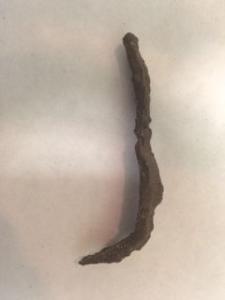One entire wall of the plantation-era tabby structure was splotched in grease, but archaeologist Marie Meranda did not suspect shabby 19th century housekeeping.
But when the team conducting the recent archaeological dig at Gascoigne Bluff found a meat hook, that was a big clue.
“I’ve been working this field for a while, and I’ve never seen a meat hook,” Meranda said. “A meat hook is a very specialized piece of equipment. I think we have a smokehouse.”
 This potential smokehouse was the most significant find unearthed during a two-week dig near the Historic Hamilton Plantation Cabins and Grounds at Gascoigne Bluff on St. Simons Island. Other artifacts included American Indian pottery, china, pipe stems and homemade nails.
This potential smokehouse was the most significant find unearthed during a two-week dig near the Historic Hamilton Plantation Cabins and Grounds at Gascoigne Bluff on St. Simons Island. Other artifacts included American Indian pottery, china, pipe stems and homemade nails.
The Coastal Georgia Historical Society sponsored the dig, which took place in advance of a drainage pipeline that will serve the Mariners Landing townhouse community, which is under construction at Hamilton and Sea Island roads.
The county gave the historical society’s archaeological team permission to take shovel samples every 5 to 10 meters along the path of the drainage pipe, which will run about 600 feet from Arthur J. Moore Drive west to the Frederica River.
 The team discovered the corner of a tabby foundation between the historically preserved slave cabins and Epworth by the Sea’s Strickland Auditorium. The find was significant enough that the county gave the team permission to investigate further, Meranda said. In the immediate area, they found evidence of a wall, unadorned ceramics, and then the meat hook. Grease was found throughout.
The team discovered the corner of a tabby foundation between the historically preserved slave cabins and Epworth by the Sea’s Strickland Auditorium. The find was significant enough that the county gave the team permission to investigate further, Meranda said. In the immediate area, they found evidence of a wall, unadorned ceramics, and then the meat hook. Grease was found throughout.
“We found a wall-fall, where the wall had fallen over and literally collapsed,” said Meranda, who is serving a post-graduate internship with the historical society. “The swirl (of material) was very greasy and charcoaled. All of the ceramics I’m finding were very utilitarian and not decorative at all. And the grease was really thick, almost like a tar, which would lend itself to the theory that this was a smokehouse.”
The smokehouse was part of Hamilton Plantation, which thrived from the 1790s up to the Civil War era of the 1860s, Meranda said. Smokehouses were a necessity for preserving meats in those distant times before refrigeration. This particular foundation was 11.5 feet by 10 feet, she said.
Little has been written about the Hamilton Plantation, and no representations of the layout survive, said Janis Rodriguez, a member of the Cassina Garden Club. Cassina maintains the two historic slave cabins, the only remains of the Hamilton Plantation above ground.
 “I was not expecting to find anything, so it was surprising,” said Meranda. “I was very excited to actually find something and add to what we know about the Hamilton Plantation.”
“I was not expecting to find anything, so it was surprising,” said Meranda. “I was very excited to actually find something and add to what we know about the Hamilton Plantation.”
The other artifacts were found during shovel tests elsewhere. None, however, warranted further digging. All the artifacts that were uncovered still have to be cleaned, dated and processed, Meranda said.
By the terms of the agreement, everything found will become the property of the county, which can display them in local libraries and museums.
“This island has a very rich cultural history and I think it’s very important to document that for future generations,” Meranda said.
Written by Larry Hobbs, The Brunswick News, Published 11/4/2015.
Photos provided by the Coastal Georgia Historical Society.